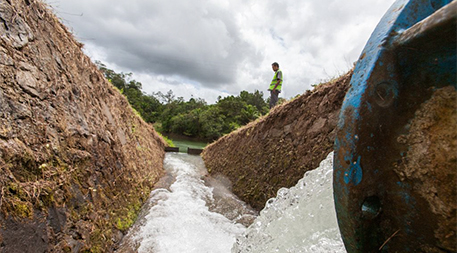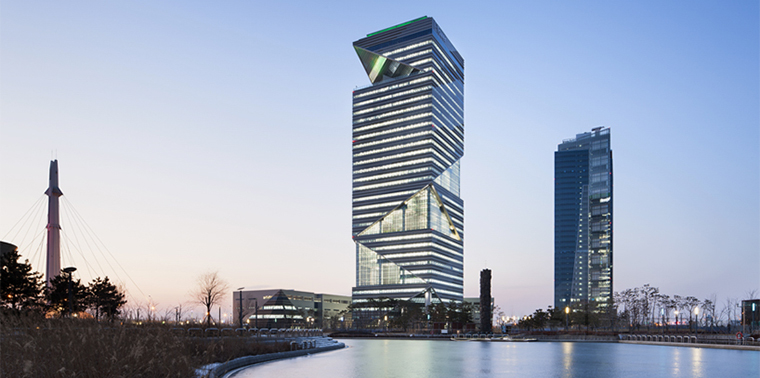April 28, 2016 — When the world’s poor countries demanded action during the failing United Nations–led climate negotiations in Copenhagen in 2009, the U.S. government responded with a promise: It would help raise US$100 billion a year by 2020 to assist efforts to cope with climate change in the global south.
Out of that commitment has slowly grown a peculiar but potentially important institution known as the Green Climate Fund. The fund has nowhere near US$100 billion to spend, but, if all goes according to plan, it will deliver significant aid to impoverished nations that are threatened by a warming planet.
The idea behind the fund is simple: The world’s rich nations, led by the U.S. and Europe, are responsible for most of the greenhouse gases that cause climate change, but the burdens of a warming planet fall most heavily on poor countries. Consequently, the fund takes from the rich and give to the poor — like Robin Hood, but with the legal and political backing of the U.N.
The GCF intends to support clean energy, low-carbon cities, low-emission agriculture, forestry and climate adaptation. Tunisian economist Héla Cheikhrouhou, the fund’s first executive director, has said that its goal is nothing less than to help poor countries overcome “the twin threats of climate change and poverty.”
What by no means is clear is whether the GCF can achieve those goals — or even how the fund, with its unwieldy governance structure, will answer a series of fundamental questions about how it intends to do business. That’s where things get complicated — and contentious. Should the fund make grants, low-interest loans, market-rate loans or equity investments? Should the money go to governments, businesses or nonprofits? Should the fund support efforts to clean up fossil fuels, in particular capture and sequester carbon dioxide from coal plants?
Environmental activists say the fund needs to do more to devolve power to those it is designed to help. By contrast, corporate observers say the fund must do more to welcome private-sector partners.
“The Green Climate Fund is struggling with an identity crisis,” says Athena Ballesteros, director of the finance center with the World Resources Institute, who has followed the GCF closely.
Because the GCF is the world’s only financial institution devoted solely to climate finance in the developing world, its actions are being closely watched. Environmental activists say the fund needs to do more to devolve power to those it is designed to help; they worry that local communities aren’t being sufficiently involved in decision-making, and they are wary of big companies that want to profit from the fund. By contrast, corporate observers say the fund must do more to welcome private-sector partners.
All agree that the fund has the potential to drive what, in its governing document, it calls “a paradigm shift towards low-emission and climate-resilient development pathways” — even if no one is quite certain about what that means.
Slow to Gain Traction
Based in Songdo district of Incheon, South Korea, the GCF for now is just a blip on the global landscape of climate finance. Some 42 countries have pledged US$10.3 billion to the fund between now and 2018. Donor governments have formally approved about US$7 billion. The U.S. has promised $3 billion and sent the bank US$500 million earlier this year.
So far, the fund has approved just US$168 million for eight projects, including a venture fund to support off-the-grid energy in Africa, energy-efficiency bonds for Latin America, an adaptation effort in Bangladesh and protection for the clean water supply on the Pacific Island nation of Fiji. The fund says it aims to approve US$2.6 billion of projects by the end of 2016.

The Green Climate Fund has approved money for a project to protect the clean water supply in Fiji. Photo by Luis Ascui/ADB
In comparison, about US$391 billion was invested in low-carbon and climate-resilient growth in 2014, according to the Climate Policy Initiative, which tracks both public and private climate finance. That sounds like a lot — and it is — but experts have estimated that as much as $1 trillion a year is needed to meet the national climate pledges countries made leading up to the Paris climate talks.
The GCF has been slow to gain traction because, like many U.N. institutions, it aims to balance an array of competing interests. Policies and projects must be approved by a 24-member board equally drawn from developed and developing countries that also must strive for gender balance (for now, three of the 24 are women). Decisions must be made by consensus.
Cheikhrouhou, the executive director, plans to step down in September, just as the fund is trying to grow. It has about 60 people on staff, and has been authorized to hire 80 more by the end of next year. (By comparison, the Inter-American Development Bank, which provides aid to Latin America and the Caribbean, has about 2,000 employees, while the World Bank has around 10,000.) It’s been hard to attract staff, particularly those with working spouses, to Songdo, a district built from scratch on reclaimed wetlands with limited employment and cultural opportunities. The Koreans provided financial assistance to help attract the fund; insiders say other potential locales, including Geneva and Bonn, were opposed by the U.S. officials (because they didn’t want the fund too closely identified with the U.N.) and by developing countries (who wanted it headquartered in a developing country, as South Korea is deemed to be by the U.N.’s climate agency).
“Creating new business for big banks with large fossil fuel portfolios and poor records on human rights and financial scandal would undermine the very purpose of the fund.” –Karen Orenstein
To deploy its resources, the fund relies upon institutions known as accredited entities to develop and manage projects. This, too, is controversial. Some 33 entities have been accredited, mostly development banks and government agencies. But a board decision to accredit private-sector banks, including HSBC and Deutsche Bank, has been opposed by dozens of non-governmental organizations that say HSBC is tainted by investigations of money laundering and Deutsche Bank has invested heavily in coal.
“Creating new business for big banks with large fossil fuel portfolios and poor records on human rights and financial scandal would undermine the very purpose of the fund,” says Karen Orenstein, senior international policy analyst at Friends of the Earth U.S.
But Abyd Karmali, a longtime climate finance expert at Bank of America Merrill Lynch and until recently an accredited private sector observer of the GCF board, says the best way for the fund to drive its desired “paradigm shift” is to use its resources to leverage lots of private-sector money. “Climate finance will scale via financial intermediaries that access mainstream investors,” he says.
Important Work to Do
While they may disagree about how the fund should operate, NGOs and corporate observers agree that the fund has important work to do.
The GCF “isn’t perfect, but it’s one of the best chances we’ve got to really think about how to change the model of development,” says Janet Redman, director of the climate policy program at the Institute for Policy Studies in Washington, D.C.
The opportunity, the NGOs contend, is to give power as well as money to poor countries to shape their own low-carbon future. Other development banks have been donor-driven. Liane Schalatek of the Heinrich Böll Siftung, a green political foundation, says, “Rather than bringing in some fancy technical experts from the outside, you think about how you can execute projects using local knowledge, local groups, local materials.”
If the bank doesn’t show signs of tangible progress before long, donor countries could grow impatient.
The WRI’s Ballesteros would like to see the fund support a handful of large-scale projects — such as mass transit in cities like Mumbai, Dhaka or Manila — that could be models for greener cities everywhere. But achieving consensus is a big challenge, she says: “It’s all about building a transformational pipeline of programs, and they can only do that if they bring the countries together.”
If the bank doesn’t show signs of tangible progress before long, donor countries could grow impatient. A group of 22 U.S. senators led by John Barrasso of Wyoming has asked the U.S. Senate to block any appropriations for the GCF in fiscal year 2017, when the administration is seeking US$750 million.
“Giving billions of dollars to an international climate fund is a significant waste of American resources,” the senators wrote.
But Orenstein says the U.S. and other wealthy countries should not abandon the victims of climate change. “You can’t expect a developing country that didn’t cause the crisis and bears little responsibility for it to spend its own money,” she says. “We have a polluter pays principle in this country: You break something in a store, you pay for it.”
![]()
Ensia shares solutions-focused stories free of charge through our online magazine and partner media. That means audiences around the world have ready access to stories that can — and do — help them shape a better future. If you value our work, please show your support today.
Yes, I'll support Ensia!
